The coinage of the Australian colonies 1788-1909 history
The early economic history of Australia is a large topic, better dealt with by others. I have concentrated on those aspects of that history which are relevant to numismatics in general and to coinage in particular. For example, you may note that I have nothing to say about the growth of banking which played such an important part in the development of this country, nor do I dwell on the insurrectionist years following the overthrow of Bligh for I believe that neither of these had any noticeable effect on the availability of coins in the colony.
A system born of necessity
When New South Wales was first settled in 1788 the British government made no provision for a monetary system. The settlement was viewed strictly as a penal colony which was expected to become self-sufficient within a short time. Everything would be provided by the British government through the Commissariat (government store). Salaries of government employees would be paid by government bills drawn on the English Treasury or the Navy Board and it was assumed that there would be no need for any other form of money.
Some coin probably came in the pockets of the officers and soldiers of the Crown and of the few free settlers and possibly also undetected in the possession of convicts. Writing in the November 2000 issue of the British magazine "Coin News", Edward Colgan say "Captain Phillip carried Ј400 in coin on the first fleet to fund the financial dealings of the new penal colony" but Butlin (quoting Phillip's instructions dated 25/4/1787) states that Phillip was given two directives with respect to expenditure. The first was that he should purchase supplies and livestock en route, paying by means of bills drawn on the "Lords of the Treasury". The second was that all public expenditure should be financed by "warrant", issued by Phillip himself as necessary. Military salaries were drawn against the Admiralty by the New South Wales Corps paymaster but civil expenditures were the Governor's responsibility. According to Butlin, the first expenditures Phillip incurred in the new colony was the need to pay carpenters and sawyers from Sirius and Supply for work done ashore. These accounts were settled in small Treasury bills.
It is interesting that the money against which government bills were drawn was all held in England. There was no local medium of exchange.
As early as November 1788 Governor Phillip requested a remittance of money from
England and sometime in 1790 the Kitty arrived with almost 4500 Spanish dollars
to be spent by Phillip at his discretion. The Spanish dollar (piece of eight) was
the nearest thing in existence to an international coinage and formed the principal
currency of most English colonies. The dollars slowly left the colony as they were
used to pay for goods brought in by visiting ships. Although there was a net drain
of coinage from the colony, the visiting ships left behind a variety of coins as
change from government bills. In addition to British coinage, there were guilders
and ducats from Holland, rupees and pagodas from India and several other coins as
well as a few English and Irish banknotes. The total amount was small and the coins
tended to be exported quickly as they were often the sole means available to individuals
to purchase goods from visiting ships.
In 1803 Governor King acquired 8000 Spanish dollars in two purchases of 500 at 6/-
each and 7500 at 5/- each. Apart from those purchases and that first remittance
to Phillip there was no attempt to increase the money supply. Free settlers and
convicts who had served their sentences needed to buy and sell goods and services.
Out of necessity, a fairly sophisticated system of barter became established and
many debts were paid in produce, land and labor. The government store, or Commissariat,
was the principal buyer of local produce and would issue store receipts for small
amounts. Accumulated store receipts could be redeemed for treasury bills but the
receipts themselves became negotiable instruments within the colony.
One medium of exchange was alcoholic spirits, generically called rum. Although much has been written about the use of rum as currency and the abuses which arose from its supply via the New South Wales Corps, it was just one of several commodities serving as money. Many other items such as tobacco, sugar, wheat, meat and livestock were also given and accepted.
Privately issued promissory notes also substituted for currency. In many cases these were rather crude and easily forged or were issued indiscriminately by individuals without the resources to redeem them. Notes often remained in circulation for long periods and some were never presented for payment.
The Proclamation (November 1800)
By 1800 most of those original 4500 dollars had disappeared but left in their wake a polyglot of British and foreign coins. The total quantity was quite small and steadily diminishing while New South Wales remained a net importer of goods. There was no general agreement on the relative values of the various coins in circulation. For example, some merchants accepted dollars at 4/6, some at 4/8, some at 5/-. The confusion must have been readily apparent to King because he had only held the office of Governor for a few weeks when in an attempt to rationalise the situation and to retain circulating coinage in the colony, Governor King issued a proclamation fixing the value of various coins in terms of British money, albeit at somewhat inflated values. The idea was that whereas a guinea would be valued Ј1/2/- within the colony, its value would still be Ј1/1/- to an itinerant trader who, it was assumed, would be unwilling to accept a guinea as payment for Ј1/2/- worth of merchandise.
Proclamation
Whereas representations of the want of small money experienced here have induced
His Majesty to take into His gracious consideration the immediate relief from this
great inconvenience to all classes of his subjects in this colony, the quantity
of copper coin has been received from His Majesty's armed vessel Porpoise and Royal
Admiral, and will be circulated by being paid for grain and animal food supplied
to His Majesty's stores.
These are therefore to give notice that a copper coin, weighing one English ounce,
and stamped with the profile of His Majesty on the one side, and of Britannia on
the other, will be issued on above at the rate of twopence for each copper; and
that the same shall pass current in the colony, and is to circulate at the aforesaid
rate of two pence.
And that no one may plead ignorance of the rate or legality of this or any other
of the coins circulating in this colony, of which it does not appear that any regular
proclamation has ever collectively been issued, I have judged it most expedient
herewith to publish the following table of all the specie legally circulating in
this colony with the rate affixed to each at which they shall be considered and
be legal tender in all payments or transactions in this colony.
| Table of specie |
Ј |
s. |
d. |
|
A Guinea |
1 |
2 |
0 |
|
A Johanna |
4 |
0 |
0 |
|
A half-Johanna |
2 |
0 |
0 |
|
A ducat |
0 |
9 |
6 |
|
A Gold Mohur |
1 |
17 |
0 |
| A Pagoda |
0 |
8 |
0 |
|
A Spanish dollar |
0 |
5 |
0 |
|
A Rupee |
0 |
2 |
6 |
|
A Dutch guilder |
0 |
2 |
0 |
|
An English shilling |
0 |
1 |
1 |
|
A copper coin of 1oz |
0 |
0 |
2 |
When a sufficient quantity of copper coins is received in the colony, of which notice
will be given, no private notes or goods will be allowed to circulate.
This supply of copper coin having been sent to relieve the inconvenience of persons
requiring to make small payments, no persons are to collect the same for the purpose
of making large payments, nor shall it be deemed a legal tender to offer the same
in payment for any sum exceeding five pounds.
And it is hereby declared that the exportation or importation, except from His
Majesty's Treasury, of any sum exceeding five pounds of the above-named copper coin,
shall be punished by fine of treble the value, and forfeiture of the sum exported
or imported.
Phillip Gidley King
P Monday November 20th, 2000
G. S. Parramatta
Note that the over-valuation of the coinage was most apparent in the smaller denominations.
Whereas a guinea gained less than 5%, a shilling gained over 8% and a penny, 100%.
Note:
The proclamation above was quoted from Renniks.
The values in the table match those listed by McDonald
but Butlin quotes the value
of the shilling as 1/8 in his table and explicitly mentions that figure in the text
(p40). 1/8 is quite a lot higher than the value listed by the other authors. Andrew
Crellin of Monetarium has a photocopy of the original document and confirms that
the values quoted by Renniks and McDonald are correct.
It is important to understand the coinage in circulation in 1800 and subsequent years was not limited to what was explicitly mentioned in King's proclamation. We can be sure that there were sixpences and three pences, half mohurs, half-guineas, third-guineas as well as Spanish doubloons in the colony. Indeed, the basis of fixing the Johanna at Ј4 was surely the equivalence of that coin with the Spanish 8 escudos and the established value of the doblуn (2 escudos) as Ј1.
As a means of keeping coins in the colonies, King's proclamation was not spectacularly
successful. Penalties for exporting coins were ignored and to compensate for the
inflated value of the coins, visiting merchants simply increased their prices. A
probable and certainly unintended side-effect of the proclamation was to reinforce
the division between "sterling" and "currency".
The term "sterling" in the early 19th century did not necessarily mean
British coinage. It simply meant reliable, trustworthy money and referred to silver
and gold coinage of any origin together with monetary instruments negotiable at
face value and ultimately backed by the British Treasury. The monetary instruments
included Treasury Bills and, by extension, government paymasters' bills and government
store receipts. Thus the term "sterling" could (and frequently did) include
instruments issued in dollars and rupees. In contrast, "currency" referred
to privately issued notes together with several commonly traded commodities such
as grain. "Currency" was considered less reliable than "sterling",
probably with good reason. Promissory notes frequently discounted to some degree
depending on the reputation and worth of the issuer, and commodities tended to fluctuate
in price so a bushel of wheat received one day might be worth considerably less
a month later. The over-valuation of copper coinage led to it being classed as "currency"
rather than "sterling".
"Currency" and "sterling" each had their part to play in the
cash-starved colonial economy but there was a premium on "sterling". A
shopkeeper was likely to give a discount to a patron who paid in "sterling".
This is not too surprising when one considers the shopkeeper's position; would he
or she prefer a bill drawn on the British Treasury countersigned by the governor,
or a hand-scribbled note issued by an ex-convict who may or may not have the means
to redeem it.
The Proclamation Coins 1788-1813
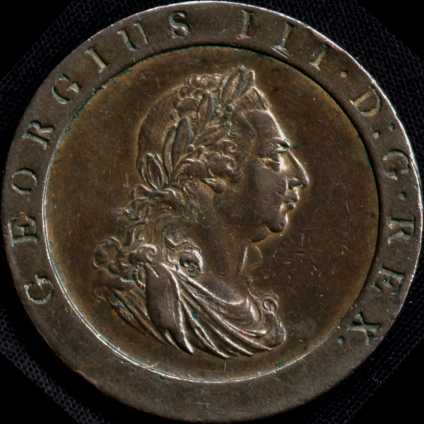
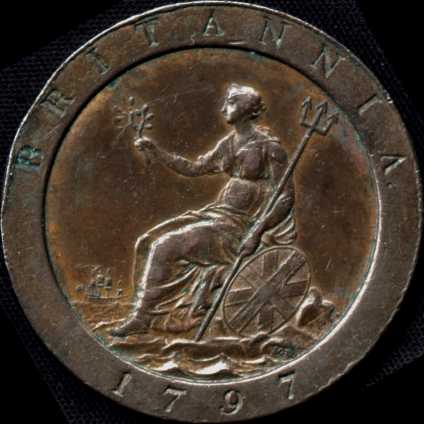
The 1oz copper coin, the "Cartwheel Penny". This was the basis for other
copper coins circulating at twice their minted value. Other denominations included
the large 2d coin valued at 4d, the halfpenny valued at 1d and the farthing valued
at ½d.
The "Cartwheel" coins were struck in coin alignment at Matthew Boulton's
mint in Soho, Birmingham using coining presses developed by Boulton and James Watt.
The concept behind the broad, raised rim was to protect the coin from undue wear.
The incuse legends were supposedly to make life difficult for forgers. The size
of the coins was a (successful) attempt to restore confidence to the coinage in
that the intrinsic value of the metal plus an allowance for the cost of production
was equal to the nominal value of the coin. The cartwheel penny weighed one ounce
avoirdupois and the twopence, two ounces.
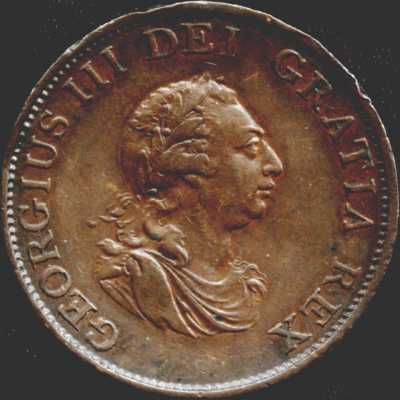
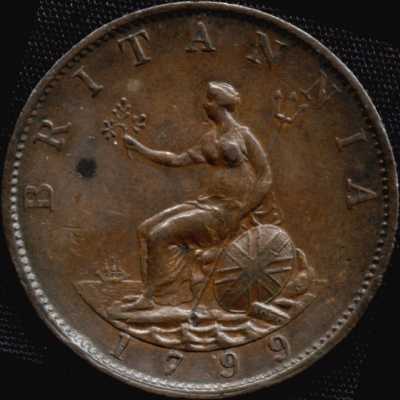
An English halfpenny dated 1799. This was not minted in the cartwheel style and
does not weigh half an ounce because by the time the contract was let the price
of copper had risen substantially.
The coin is decidedly concave and reflects Boulton's judgment that this design
was adequate for protection and his finding that it was easier to strike than the
cartwheel coins.
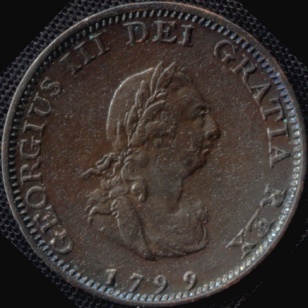
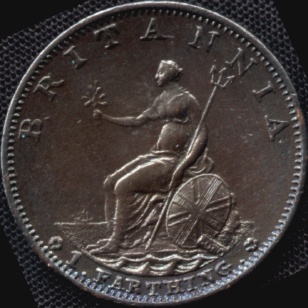
An English farthing dated 1799, not minted in the cartwheel style. It does not weigh a quarter of an ounce and the remarks for the halfpenny apply to this coin also.
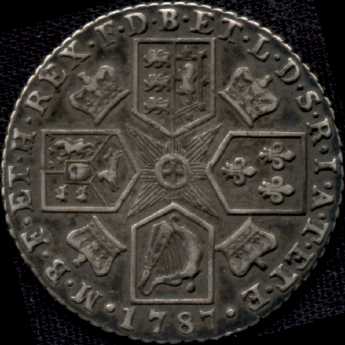
An English shilling, George III, 1787. Under the 1800 proclamation, it was valued at 1/1 in the Australian colonies.
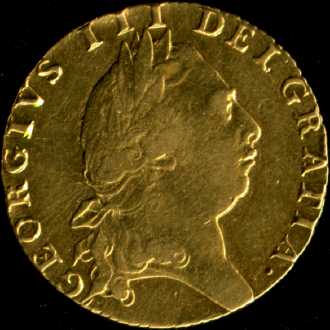
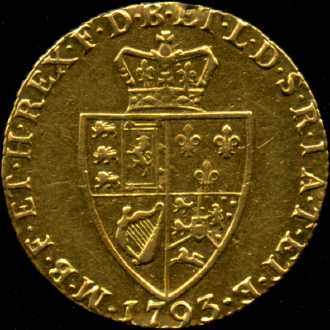
An English guinea. This specimen is the famous "spade" design. Conventional valuation was £1/1/- but King's proclamation set the value at £1/2/-. The spade guinea was struck in medal alignment.
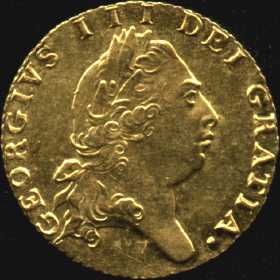
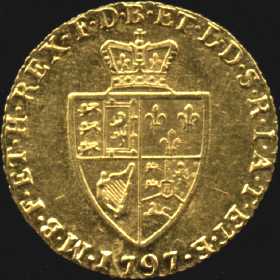
A half-guinea. This specimen is also of the "spade" design. In accordance with Governor King's proclamation, its value in the colonies would have been 11/-.
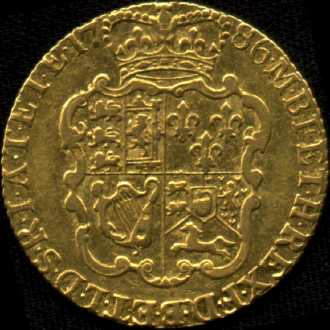
Another guinea, this time of an earlier design. Unlike the spade guinea, it was
struck in coin alignment.
Note that the obverse is quite different from that of the spade guinea even though
both picture George III.
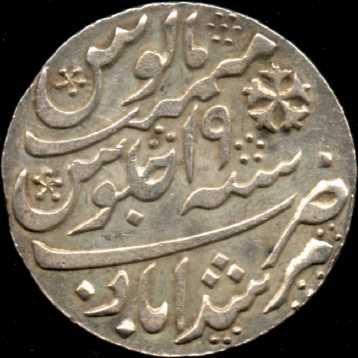
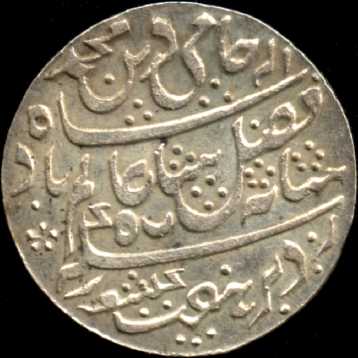
A silver rupee from India. Several different designs were in circulation in the Australian colonies and this is just one example. It was struck in medal rotation at the Murshidabad mint sometime between 1792 and 1818 and features oblique edge milling.
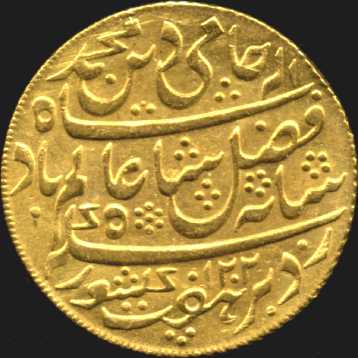
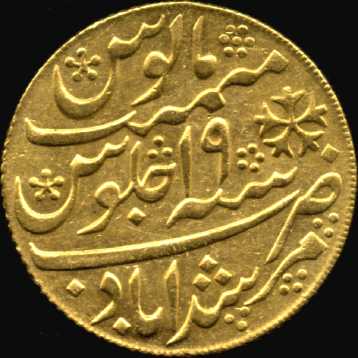
A gold mohur from India. Issued by the East India Company as a trade coin, it was minted during the Bengal Presidency at the Murshidabad Mint between 1793 and 1811 (1202 AH, Frozen Year 19). Local value was 2/6.
Local value was £1/17/-. It is about the same size as the silver rupee and likewise features oblique edge milling. It was struck in medal rotation. The designs on the mohur and the rupee are very similar but not identical.
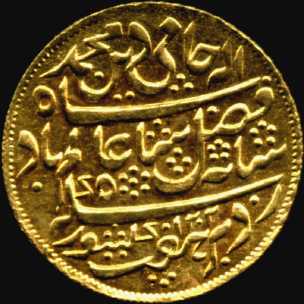
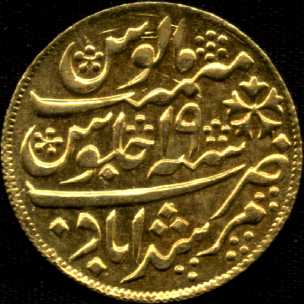
A gold half-mohur from India. Like the mohur, it was issued by the East India Company as a trade coin. It was minted during the Bengal Presidency at the Murshidabad Mint between 1793 and 1818 (1202 AH, Frozen Year 19) Not explicitly mentioned in King's proclamation, its local value was naturally 18/6, half that of the full mohur. The design is very similar to that of the full mohur and was likewise struck in medal rotation.
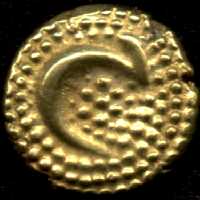
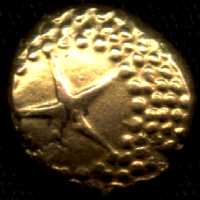
Two gold pagodas from India. Like the rupee, several different designs circulated in the Australian colonies. The first example is from the state of Mysore and was minted under Haidar Ali between 1761 and 1782. The obverse features Sivan and Parvati. The second example is of a well-known design, called the "star pagoda" because of the prominent feature on the reverse. This particular specimen is encrusted with iron oxide which partly obscures Vishnu on the obverse. It was minted under the Madras Presidency sometime between 1740 and 1807. Pagodas were tiny, bulbous coins about 9mm in diameter and weighing 3.4g with a proclaimed local value of 8/-.
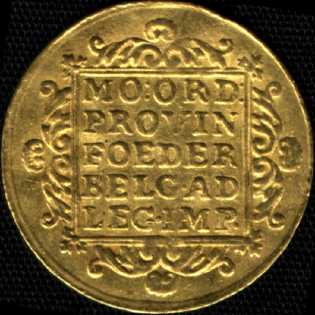
A gold trade ducat from the Netherlands. In Governor King's proclamation of 1800 this coin was given a value of 9/6. The ducat was struck in coin alignment.
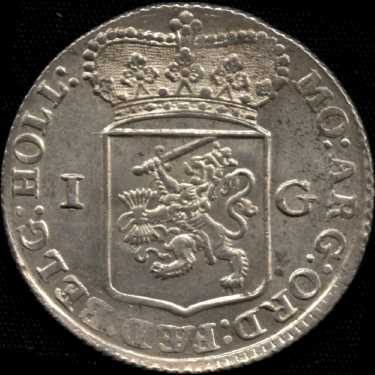
Another Dutch coin, this time a silver guilder (alt sp. gulden). These were minted in several regions and this specimen comes from Holland province. Its local value was set at 2/-. Unlike the ducat, this coin was struck in medal rotation.
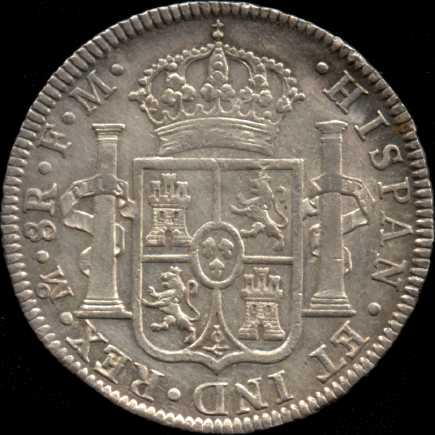
This is a "Spanish Dollar" or "piece-of-eight" and was the nearest thing in existence to a world currency unit at the end of the 18th century. It formed the basic currency of most British colonies of the time, including, of course, those in North America. The specimen shown was minted in Mexico as indicated by the mint mark at about 8 o'clock on the reverse just before the denomination, 8R, signifying eight reales. It was struck in medal rotation. Local value was set at 5/-.
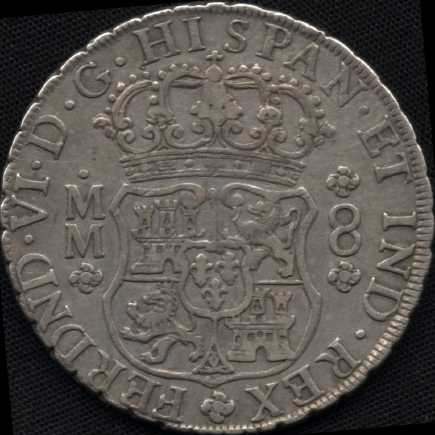
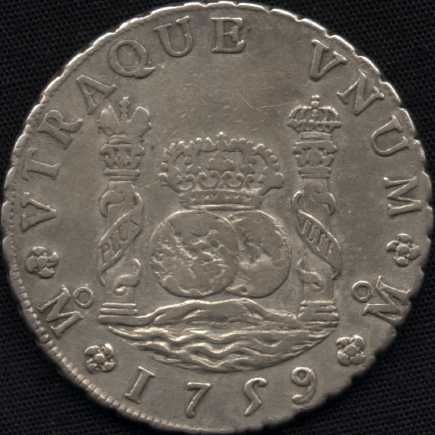
An earlier 8 reales coin. This one was known as the "Pillar Dollar" and bears the date 1759. Like the one above, this is also from the Mexico Mint and was struck in medal rotation.
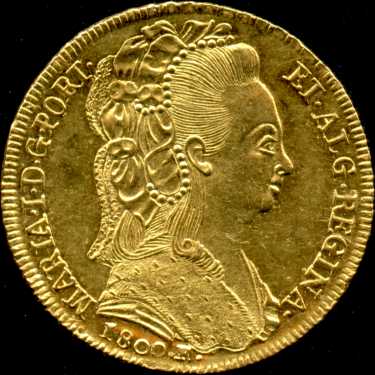
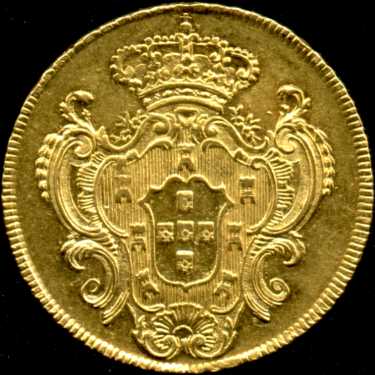
A half-Johanna from Portugal or its colonies. This 6400 reis (4 escudos) coin had a local value of £2. The specimen shown is from Brazil. It was struck in medal rotation.
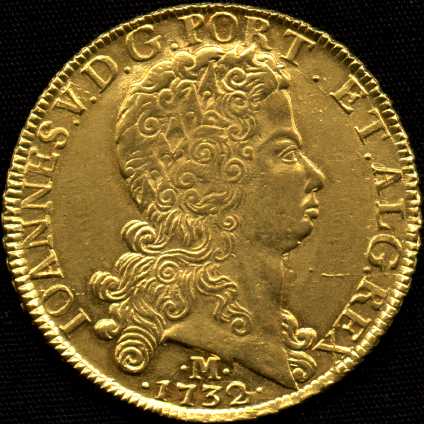
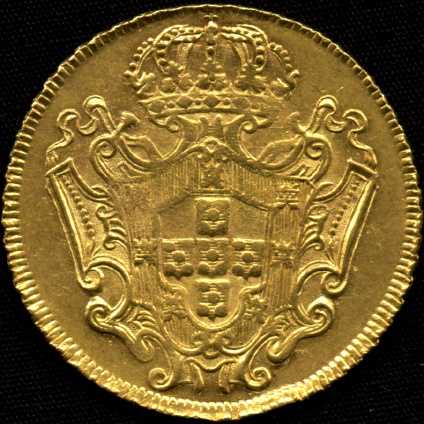
A Johanna from Portugal or its colonies. This 12.800 reis (8 escudos) coin had a local value of £4 and was the highest denomination coin covered in King's proclamation of 1800. The specimen shown is from Brazil and weighs 28.5g. It was struck in medal rotation.
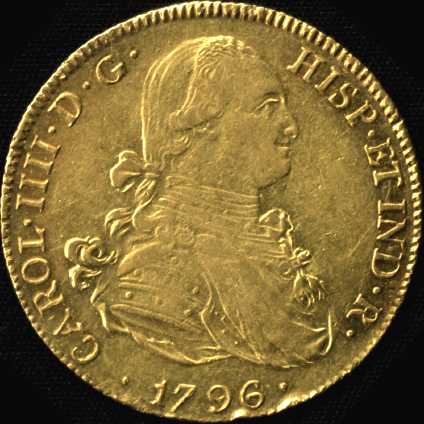
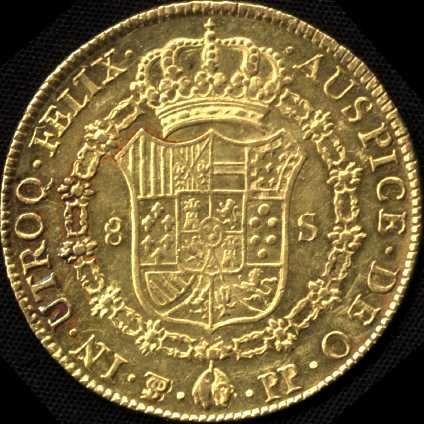
This gold 8 escudos coin was the Spanish equivalent of the Portuguese Johanna and as such had a local value of £4. The specimen shown is from the Potosi mint in Bolivia and was struck in medal rotation. The Potosi mintmark is the monogram at the bottom of the reverse, just left of centre.
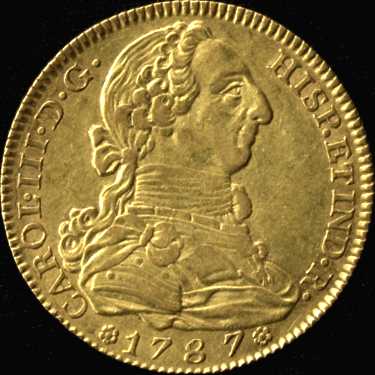
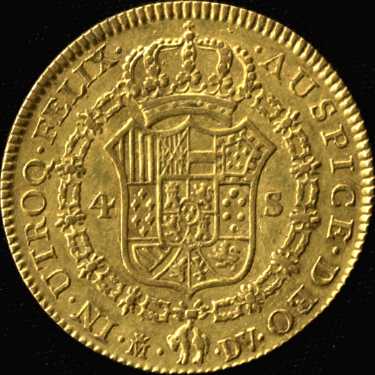
Another de-facto proclamation coin, this 4 escudos coin was the Spanish equivalent of the half Johanna and as such had a local value of £2. The specimen shown is from the Madrid mint in Spain and was struck in medal rotation.
The Holey Dollar
The acquisitions of Spanish dollars in 1803 were just about exhausted by the time
that Lachlan Macquarie took up his post as the Governor of New South Wales near
the end of 1809. In October 1810 Macquarie requested a supply of Ј5,000 in
copper coin to be issued at double value as in King's time. While nothing came of
that, Macquarie reiterated through proclamation that copper coin was legal tender
for amounts up to Ј5 while extending that limit indefinitely for bills whose
mode of payment was specified as copper. The Ј5 limit was later reduced to
1/3 (i.e. 1s 3d) after the issue of the holey dollar.
In November 1812, Macquarie received 40,000 Spanish dollars shipped from India
by the East India Company under contract from the British government and with instructions
from the Earl of Liverpool to take measures to ensure that they remained in the
colony. To this end Macquarie engaged the services of silversmith and convicted
forger, William Henshall, to punch the centre out of each coin yielding a "ring"
and a "dump". Each piece was to be counterstamped with its nominated value;
the ring at 5/- and the dump at 1/3. Thus Ј10,000 would yield coinage with
a circulation value of Ј12,500. In practice, about 100 coins were lost during
the early stages of production because of difficulties with the machinery. These
difficulties led to some considerable delay in delivery of the new coins so that
although they were dated 1813, none was actually sent to the Commissary until early
1814. The whole exercise was completed by August of that year.
The term "holey dollar" was not used officially until about 1820 but
it seems likely that that unofficial use of the name was almost immediate.
Today fewer than 300 genuine holey dollars are known and maybe 1500 dumps exist.
For more information see the catalogue by Mira and Noble
which also shows pictures of most of the surviving holey dollars. Another article
worth reading is the one by Stewart McLeod
in JANS.
Just a couple of examples of a holey dollar and one of a dump. The references
are to the Mira/Noble catalogue
"The Holey Dollars of New South Wales".
For identifying the original coins, the best reference I have is Yriarte and
Sanchez but that may be a
difficult resource because only 2000 copies were ever printed.
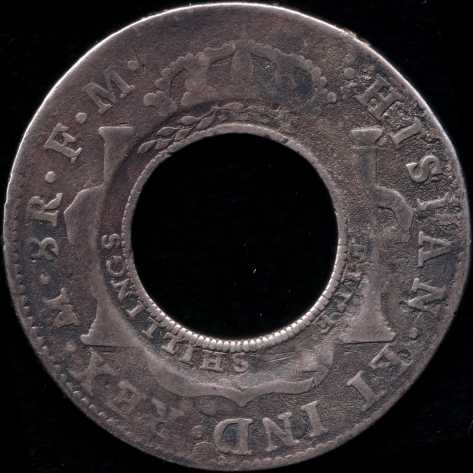
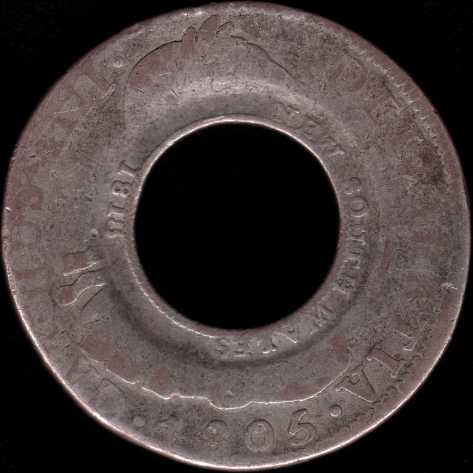
Obverse: 1805, Charles IIII
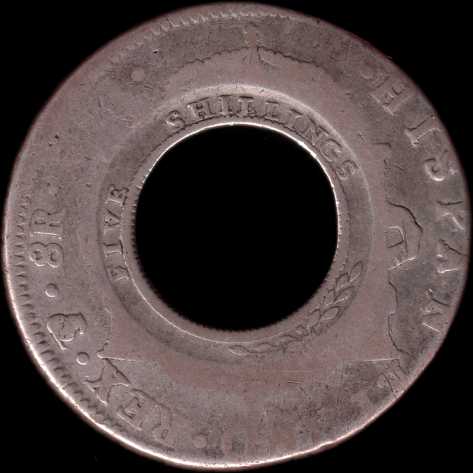
Reverse: Potosi mint (see JPS monogram at the 8 o'clock position.)
A type A/1 dump
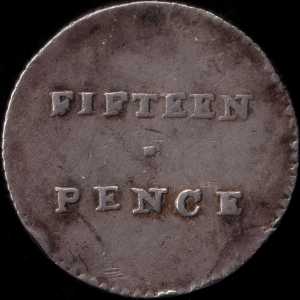
In these pictures, the dump is not on the same scale as the holey dollars. The holey dollar is shown at one quarter resolution whereas the dump is shown at one third resolution. This means the dump looks larger than it should in comparison to the ring dollar. Even if the pictures were to the same scale, the dump would be larger than the hole in the ring, although the difference would not be very noticeable. The diameter of the hole is 17mm and the diameter of the dump is 19mm. This meant that the dump spread quite a lot under the pressure of the counterstamp dies.
The absence on dumps of features from the original coins has been interpreted by some writers as suggesting that the dumps were smoothed before being struck. On thinking about it, I doubt that it was done. For a start, filing the dumps would have been a really tedious and wasteful process. Secondly, given the substantial metal flow in spreading a 17mm blank to a 19mm finished coin and the strike pressure needed to make that happen, one would expect that any features on the original coin would be obliterated without any need for smoothing. Incidentally, the dump has a milled edge suggesting it was struck in a milled collar. Dr Mira tells me this wasn't done; the milling was added afterwards by a procedure known as rifling.
The punch and counterstamp style of mutilation ordered and sanctioned by Macquarie
was not unique to New South Wales. A quick scan through Craig's catalogue shows that similar mutilations had
occurred in British Guiana (1808), Prince Edward Island in Canada (1813), Dominica
(1761-1818) and St Vincent (1798) and in their catalogue Mira and Noble say that
Macquarie was emulating his colleagues in the Americas and West Indies. It is conceivable
that that Macquarie or members of his staff knew of the practice, particularly from
the Caribbean colonies.
That it was possible to convert a 5/- coin into two worth 6/3 was certainly noted
with interest by some inhabitants of the colony who quickly sought to emulate the
fine example set by the government of the day. The result was a number of contemporary
counterfeits of the ring dollar and dump, a few of which are illustrated by Mira
and Noble. Some of the forgeries were crude and were executed by simply punching
out the centre of a Spanish dollar without bothering to imprint any counterstamp.
Others were more sophisticated and were really quite good forgeries. One of the
most interesting was a well-executed counterstamp with the date reversed (3181 instead
of 1813). It is difficult to imagine how the forger could have taken so much care
to produce such a good copy of the genuine article and yet still manage to make
such a glaring mistake. We can speculate that if the forger subsequently corrected
this error then he may well have succeeded in producing a significant number of
high-quality counterfeits which passed unnoticed in the colony.
Colonial dollars and dumps were current coin in the colony for several years
until they were recalled in 1822 as part of the establishment of the Spanish dollar
as the official currency of New South Wales.
The Dollar Standard
In the years 1822 to 1825 under the governorship of Brisbane, the colonies in
New South Wales came very close to adopting the dollar as the principal unit of
currency. According to Butlin, the main proponent was not Brisbane himself but the
Colonial Secretary, Major Goulburn.
Holey dollars and dumps were exchanged at nominated value provided they were
presented before 5/9/1822 in New South Wales and 21/9/1822 in Van Diemen's Land.
Thereafter the rings were re-issued as 3/4 dollars and the dumps as quarter dollars.
This was a devaluation of the holey dollar, necessary to restore parity with the
unmutilated coins. Less obviously, it was also a devaluation of the dump. During
the transition period, rings and dumps were received at 5/- and 1/3 respectively
but when the coins were re-issued the value of the Spanish dollar was set at 4/-.
(The ring had dropped in value from 5/- to 3/-.) Copper coins were to be valued
in terms of dollars, with a halfpenny equal to one cent.
The exchange rate between the dollar and the pound varied according to the type
of transaction in such a way as to suggest official profiteering and favouritism.
In 1825, for example, when the government paid for goods and services it reckoned
the dollar at 5/-, payments to troops were at a rate of 4/8, government transactions
used a rate of 4/4 and salaried officials were paid at the rate of 4/- to the dollar.
Naturally, this evoked a good deal of unrest and caused the dollar to be viewed
with some disfavour despite its acknowledged usefulness as a medium of exchange
within the colony. (See Butlin pages 150-154 for more details.)
In May 1825 the exchange rate was fixed at 4/4 for all transactions but this
did not establish the dollar as the unit of currency. It simply meant that dollars
and pounds were inter-convertible at a standard rate.
The death blow to the dollar standard was dealt by the British Treasury which
in 1825 sought to impose a uniform medium of exchange throughout all sections of
the Public Service. To this end it arranged for substantial shipments of English
coin to the colonies and issued Orders-in-Council providing that dollars could be
substituted at the rate of 4/4 until such time as sufficient English coin became
available. The first shipments of coin arrived in late 1825 and with stewardship
of New South Wales transferred to Governor Darling (and separated from Tasmania)
the gradual withdrawal of the Spanish dollar commenced.
Other Articles
The coinage of the Internment Camps
The Melbourne Centenary Florin 1935

